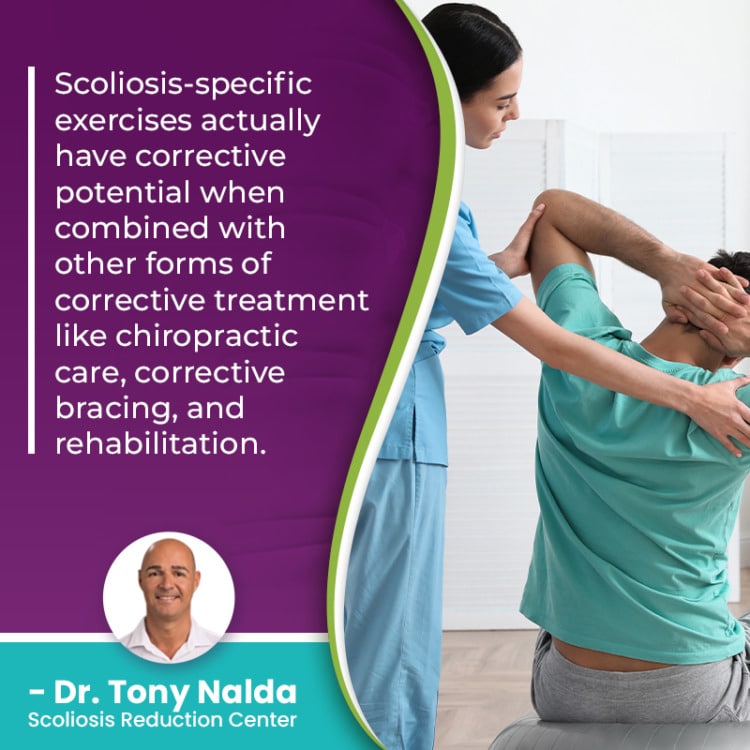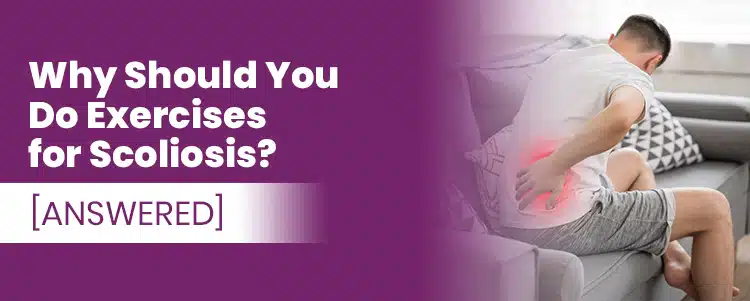Scoliosis has been around for hundreds of years, so we have had lots of time to observe the condition, how it progresses, and how it’s affected by exercise. While no exercise regimen should be attempted before it’s first cleared by a patient’s treatment provider, scoliosis-specific exercises can help in a number of ways.
There are different reasons to do exercises for scoliosis, and there are also different types of exercises; exercises for maintaining spinal strength and flexibility and specific exercises that are part of treatment. There are numerous benefits to exercising with scoliosis, as long as it’s done safely.
There was a time when a diagnosis of scoliosis was thought to mean a sedentary life of limitations, but we now know that’s not the case.
Being Diagnosed with Scoliosis
Being diagnosed with scoliosis can be difficult news to process, but the good news is that while scoliosis is incurable, it can be highly treatable.
As a progressive condition, scoliosis has it in its nature to get worse over time, but with proactive treatment, patients can not only survive their diagnosis, but can thrive with it; one only has to look at the number of professional athletes and celebrities who are fulfilling their life’s goals and dreams while living with the condition.
Being diagnosed with scoliosis means an unnatural sideways-bending and rotating spinal curve has developed, and this introduces a lot of uneven forces not just to the spine, but also its surrounding muscles, nerves, and the entire body.
There are three main spinal sections: the cervical spine (neck), the thoracic spine (middle/upper back), and the lumbar spine (lower back).
Scoliosis can develop in any of the spine’s main sections or in more than one as a combined scoliosis.
When vertebrae become unnaturally tilted, this disrupts spinal alignment, the spine is no longer held in a neutral position, and the biomechanics of the entire spine are disrupted.
We’re talking generally about why people with scoliosis should do exercises, so let’s take a look at the different ways exercising can help.
Exercise and Pain Management
Scoliosis is a highly-variable condition, meaning no two cases are the same, and it ranges widely in severity from mild scoliosis to moderate scoliosis, severe and very severe scoliosis.
Scoliosis is progressive, meaning it has it in its nature to get worse over time, so patients need to understand that where a scoliosis is at the time of diagnosis isn’t indicative of where it will stay, at least not without the help of proactive treatment.
So condition effects will get worse over time as a patient’s scoliosis gets worse, and the more severe scoliosis is, the more noticeable its effects will be; the main condition effects in children are postural changes and in adults, it’s pain.
Scoliosis doesn’t become a compressive condition until skeletal maturity has been reached; it’s compression of the spine and its surrounding muscles and nerves that causes the majority of condition-related pain.
When scoliosis gets worse, the size of the unnatural spinal curve is increasing, and this makes the spine increasingly rigid, and as it’s not just the spine that has to maintain its natural curves and alignment, but also its surrounding muscles, they are also affected, and muscle pain can become an issue.
So scoliosis exercises and stretches can help keep the spine flexible, and this makes it more responsive to treatment, less rigid and painful, and it also makes it possible for patients to perform certain therapeutic exercises that are key to treatment.
Physical therapy and exercises can help keep the spine strong, loose, and can also help keep the spine’s surrounding muscles strong and lose, preventing them from becoming strained and sore.
Exercise and Muscle Strength
As mentioned, it’s also the core muscles that help support and stabilize the spine, so they are also affected by the development of an unnatural spinal curve.
The spine’s surrounding muscles can become sore and unbalanced as the unnatural spinal curve pulls them in different directions and they can become strained as a result.
Muscle imbalances are also common as the muscles on one side of the spine are strained from overuse, and muscles on the other side of the spine are weak from underuse.
Certain scoliosis-specific exercises can help keep the core muscles strong for more support, and this is a key goal of treatment, and addressing any muscle imbalance also keeps the muscles strong, loose, and helps prevent painful muscle spasms.
Stronger muscles are better able to support the spine, reducing back pain, and the condition is less likely to progress as quickly as in someone with less core stability and strength.
Exercise and Corrective Treatment Results
When it comes to scoliosis treatment options, there is traditional surgical treatment and conservative non-surgical treatment.
Here at the Scoliosis Reduction Center®, patients benefit from a proactive conservative chiropractic-centered treatment approach that has the ultimate goal of correcting scoliosis, and exercises are a large part of treatment.
Scoliosis-specific exercises can help augment corrective treatment results by increasing core strength, addressing any muscle imbalance, can improve posture, and activate certain areas of the brain for enhanced brain-body communication and better body positioning.
In order to correct scoliosis, it has to be impacted on a structural level because the condition’s underlying nature is structural: involving an abnormality within the spine itself.
Chiropractic treatment works towards repositioning the curve’s most-tilted vertebrae back into alignment with the rest of the spine, but the spine needs to be supported by strong muscles, and this is where a scoliosis-specific physical therapist can help.
Muscle symmetry is important and exercises and stretches can help ensure the spine is supported by balanced muscles on both sides.
Core stabilization also helps improve posture by strengthening abdominal muscles and establishing a strong center of gravity; a person’s center of gravity can naturally shift due to the change in the spine’s position and the condition’s uneven forces.

So scoliosis-specific exercises actually have corrective potential when combined with other forms of corrective treatment like chiropractic care, corrective bracing, and rehabilitation.
Exercises and Rehabilitation
As scoliosis is a progressive and incurable condition, continued efforts are needed to sustain treatment results for the long term.
Once corrective treatment results have been achieved, this means the size of the scoliotic curve has been reduced on a structural level and the spine’s surrounding muscles are stronger and can optimally support it.
When corrective bracing is prescribed, it can help by pushing the spine into a corrective position, and once a patient’s Cobb angle has been reduced, corrective results have been achieved.
But continued chiropractic care and a home exercise program is needed to further stabilize and heal the spine for long-term sustainable treatment results.
A series of custom-prescribed scoliosis-specific exercises can be performed from home to keep the spine strong, loose, flexible, and to keep its surrounding muscles as strong and healthy as possible so they can optimally support and stabilize the spine.
So in the end, exercises, when scoliosis-specific and prescribed by a scoliosis physical therapist, can help with maintaining a healthy body weight (less pressure on the spine), improving spinal mobility, scoliosis pain, encouraging good posture, increasing back muscles strength, augmenting corrective treatment results, and rehabilitating the spine.
Conclusion
When it comes to exercising with scoliosis, patients need to make sure they are first cleared with their treatment provider, but when designed by a scoliosis physical therapist, they can help correct scoliosis by making the spine more responsive to treatment.
A spine that’s stronger and more flexible is going to respond to chiropractic treatment faster, and a spine that’s surrounded by strong supportive muscles is one that’s going to be better able to maintain its healthy curves and alignment.
A person with a strong core has more stabilization and is better able to counteract the condition’s uneven forces, and postural awareness is also important for scoliosis patients.
A personal trainer who understands scoliosis can help teach proper technique, and schroth exercises and seas exercises are known for their corrective potential that can benefit patients in different ways.
Exercises and stretches can also help reduce pain by keeping the spine loose, flexible, strong, and also addressing any related muscular symmetry.
Performing the right exercises as part of treatment can help create an environment inside the body that’s more conducive to healing, and even when it comes to diagnosing scoliosis, this is more easily achieved with patients who aren’t carrying excess weight (the spine is more visible, and its effects are more noticeable).
A scoliosis specialist can also develop programs for further healing and rehabilitating the spine from home for sustainable long-term treatment results.




